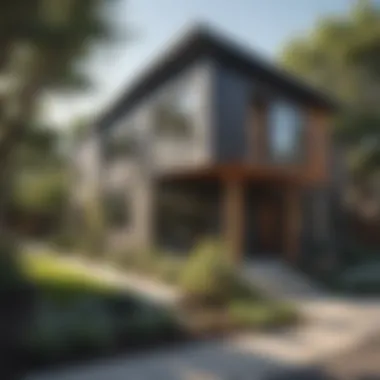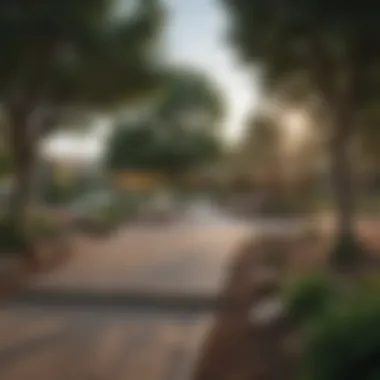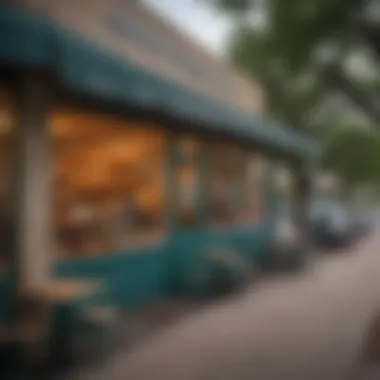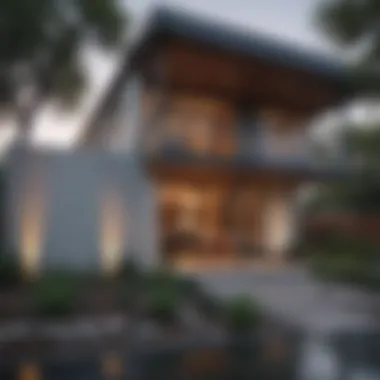Discover Austin's Emerging Neighborhoods: A Guide


Intro
Austin, Texas, is not just a tech hub; it is also a city embracing change in many neighborhoods. The landscape is shifting, welcoming new developments and cultural influences. For homebuyers and design enthusiasts, this presents exciting opportunities. Understanding the essence of new neighborhoods can greatly influence residential choices. From architectural designs to community amenities, each area offers a distinct lifestyle. This guide aims to showcase the transformative neighborhoods in Austin, highlighting their unique attributes.
Featured Homes
In assessing neighborhoods, the type of homes available plays a crucial role. Each emerging area in Austin boasts a unique blend of architectural styles and modern designs.
Architectural Highlights
Many new constructions embrace sustainable practices while prioritizing aesthetic appeal. Homes in the Mueller neighborhood illustrate this approach. They feature elements like solar panels, green roofs, and energy-efficient materials. The blend of contemporary designs with touches of traditional Texan architecture creates an appealing look. In contrast, the homes in the East Riverside area focus on artistic expressions. You can find colorful murals, vibrant details, and open designs that promote social interaction.
Interior Design Themes
Interior design reflects the lifestyle of the inhabitants. In neighborhoods like Domain, modern luxury meets minimalism. Bright open spaces, sleek furniture, and high-end finishes mark the interiors. Meanwhile, homes in the South Congress area often showcase eclectic styles. They merge vintage finds with contemporary elements, creating a warm and inviting atmosphere.
Location Spotlights
The neighborhoods are not only about homes. They provide cultural experiences and natural beauty that can contribute to lifestyle choices.
Cultural Significance
Some neighborhoods in Austin embody a rich cultural tapestry. The North Loop is an artistic hub filled with vintage shops and local cafes. The community supports small businesses. Events and festivals highlight local artists, fostering a sense of unity.
Natural Wonders
Access to nature can greatly enhance quality of life. Areas like Zilker Park offer residents a quick escape into beautiful green spaces. Jogging trails and picnic spots abound. The untouched natural beauty near Lady Bird Lake also acts as a sanctuary for wildlife and residents alike.
"Living in Austin is not merely about the house you choose. It’s about the vibrant life surrounding it."
Investing in these neighborhoods is not simply a financial decision; it is about embracing a lifestyle. For those looking to relocate or invest, understanding these neighborhoods is key. The blend of modern architecture, cultural significance, and access to nature creates an evolving tapestry to explore.
Prolusion to Austin's Housing Market
Austin, Texas has become a prominent player in the real estate market. Interest in this city is growing due to its unique blend of culture, technology, and natural beauty. As the housing landscape undergoes transformation, it is crucial to understand the current market dynamics.
Current Trends in Urban Development
In recent years, Austin's urban development has focused on sustainability and mixed-use spaces. New housing developments are designed to foster community and reduce reliance on cars. Projects like the Domain offer residential, retail, and office spaces in one area, making it convenient for residents. The East Riverside Corridor is another area seeing significant redevelopment, with plans for high-rise buildings and public parks. These trends reflect a shift toward more integrated urban living.
Impact of Population Growth
Austin's population is expanding rapidly. The city attracts professionals from various sectors, especially technology. Between 2010 and 2020, the population grew by over 20%. This growth has stimulated the housing market, resulting in increasing demand. Prices in established neighborhoods have risen, pushing some buyers to explore emerging areas. The influx of new residents brings diversity and economic vibrancy but also challenges regarding infrastructure and housing affordability.
"Austin's charm and opportunities are drawing more people than ever, reshaping the housing landscape."
To fully appreciate the housing market, one must consider these key elements. They provide insights into what makes Austin an attractive location for homebuyers and investors alike.
Criteria for Evaluating Neighborhoods
Understanding the criteria for assessing neighborhoods is essential for anyone looking to relocate or invest in real estate. The right neighborhood can profoundly influence quality of life and property value. Each neighborhood offers unique characteristics and amenities that cater to different lifestyles and preferences. Evaluating these criteria ensures potential residents and investors make informed choices, finding a place that aligns with their needs and goals.
Accessibility and Transportation


Accessibility is a vital factor in evaluating any neighborhood. It encompasses not only the ease of getting to and from work but also the availability of public transportation options. In Austin, neighborhoods with good transportation links are often more desirable. Residents benefit from a sufficient network of bus routes and ride-sharing services. It's also important to consider how walkable or bike-friendly an area is. Neighborhoods that facilitate easy access to everyday needs like grocery stores and schools tend to foster a sense of community.
Moreover, neighborhoods that are strategically located near major highways or thoroughfares can offer quicker commutes. This factor is particularly relevant for professionals who work in different parts of the city. A short commute can lead to a better work-life balance and increased satisfaction for residents.
Community Amenities and Services
The availability of community amenities plays a critical role in the livability of a neighborhood. Essential services such as healthcare facilities, schools, and shopping options should be easily accessible. Residents often prioritize proximity to quality education institutions, as this can affect property value and attract families.
In addition, social amenities such as parks, community centers, and recreational facilities are vital. They encourage interaction and cohesiveness among residents. Neighborhoods with vibrant local businesses foster economic growth and provide residents with various options for dining, shopping, and entertainment. A strong sense of community can greatly enhance one's living experience, helping residents feel more connected and engaged.
Recreational Opportunities
Recreational opportunities greatly enhance the attractiveness of neighborhoods. Access to parks and natural spaces encourages outdoor activities like walking, running, and cycling. These amenities are essential for physical and mental well-being.
In Austin, neighborhoods that feature recreational facilities such as sports complexes, gyms, or pools are appealing to both families and individuals. An active lifestyle is often a priority for many residents. Furthermore, the availability of cultural venues like theaters and galleries can enrich residents' experiences, providing options for entertainment and engagement.
Housing choices can reflect the recreational opportunities available in the neighborhood. For instance, areas with abundant outdoor activities may feature more family homes or townhouses, while vibrant urban settings may focus on condos catering to young professionals.
A neighborhood's appeal relies heavily on how well it addresses accessibility, amenities, and recreational opportunities. Evaluating these criteria provides a comprehensive view of a neighborhood's potential.
Highlighting Emerging Neighborhoods
The exploration of emerging neighborhoods in Austin is crucial for understanding the city's dynamic housing market. These neighborhoods are not only economic engines, but they also highlight diverse lifestyles and community values. The distinct characteristics and evolving atmospheres of these areas offer potential homebuyers an array of options tailored to their individual needs. This section deep dives into specific neighborhoods that have shown remarkable growth and development.
East Austin: A Cultural Hub
East Austin stands out as a cultural hub, attracting creatives, artists, and young professionals. Its eclectic vibe enhances the appeal of this neighborhood, making it a vibrant place to call home.
Artistic Ventures and Galleries
Artistic ventures and galleries play a significant role in East Austin. The presence of local art studios gives the neighborhood a colorful character. For example, galleries such as the Luminations and Blue Genie Art Bazaar showcase talents from the local community. This focus on art fosters creativity and collaboration among residents, contributing positively to the overall community atmosphere. Residents benefit from their proximity to thought-provoking art, promoting a sense of community pride.
Local Dining and Nightlife
Local dining and nightlife are vital aspects of East Austin. Establishments like La Barbecue and Whisler's offer a mix of culinary experiences. These venues become gathering spots for residents, enhancing social interactions. The lively nightlife scene provides entertainment options ranging from live music to craft cocktails. This combination makes East Austin attractive to those seeking a vibrant social life aligned with great food.
North Loop: Quirky and Eclectic
North Loop is known for its quirky charm, combining a unique aesthetic with a strong sense of community. This neighborhood caters to those who value individuality and creativity.
Unique Boutiques and Shops
Unique boutiques and shops characterize North Loop as a shopping destination. Places like End of an Ear and Strange Brew Coffee create an environment for local entrepreneurs to thrive. Shoppers are drawn to the originality of goods offered, which is different from mainstream shopping experiences. This emphasis on local businesses strengthens community ties and supports economic sustainability in the area.
Community Events and Engagement
Community events in North Loop foster active engagement among residents. Events like the North Loop Flea Market bring neighbors together, encouraging participation and collaboration. This sense of belonging enhances community identity. These gatherings help build relationships and provide opportunities for residents to showcase their talents and interests.
Mueller: A Planned Community
Mueller represents a model of what modern urban planning can achieve. It combines residential and commercial spaces around green environments, making it attractive for families and professionals alike.
Green Spaces and Parks
Green spaces and parks are a hallmark of the Mueller community. The Mueller Lake Park offers recreational options such as walking trails and picnic areas, enhancing residents' quality of life. Access to parks promotes outdoor activities and community gatherings. This aspect appeals to families looking for safe and engaging environments for their children.


Modern Living Solutions
Modern living solutions describe the housing options available in Mueller. The community features energy-efficient designs and sustainable building practices. This progressive approach attracts eco-conscious buyers seeking a contemporary lifestyle. Such features have clear advantages, appealing to those prioritizing sustainability in their living choices.
Travis Heights: A Blend of Historic and Modern
Travis Heights combines historical significance with modern amenities. This neighborhood illustrates the charm of Austin's past while embracing contemporary living.
Architectural Significance
Architectural significance is evident throughout Travis Heights. Many homes preserve unique styles that reflect the city’s history. The iconic Dahlgreen House showcases historical architecture that attracts enthusiasts. This connection to history adds richness to the neighborhood, appealing to those who appreciate aesthetics and heritage.
Community Feel and Interaction
Community feel and interaction are strong components of Travis Heights. Local events and neighborhood gatherings foster relationships among residents. Parks and community spaces like Gus Fruh Park serve as hubs for socializing. These interactions create a warm, welcoming atmosphere, essential for those seeking a sense of belonging in their community.
South Lamar: Vibrant Residential Life
South Lamar is characterized by its vibrant style, blending residential life with numerous amenities. This neighborhood attracts those who enjoy both community engagement and cultural vibrancy.
Dining and Entertainment Options
Dining and entertainment options in South Lamar are abundant. Restaurants like Uchi and Bouldin Creek Cafe showcase diverse culinary backgrounds. This variety attracts food lovers eager to explore new dining experiences. These establishments significantly enrich the community, transforming dining into a social adventure.
Trends in Home Design
Trends in home design are noticeable in South Lamar. Contemporary architecture blends seamlessly with the surrounding environment, reflecting current housing preferences. Features such as open floor plans and sustainability become highlights. This modern approach satisfies both individual and family needs, appealing to a broad range of potential buyers.
Evaluating the Real Estate Landscape
Evaluating the real estate landscape in Austin is essential for understanding the shifting dynamics of this vibrant city. Neighborhoods are undergoing changes, driven by new developments, evolving demographics, and increasing demand for housing. Homebuyers must assess these market conditions to make informed decisions. This section outlines critical components that impact real estate evaluations in the Austin area.
Price Trends and Market Viability
In recent years, Austin has witnessed notable fluctuations in housing prices. The appeal of the city has attracted a diverse population, creating competition for limited inventory. Understanding price trends helps potential buyers gauge where the market is heading. As of late 2023, the average price of homes has increased significantly, reflecting the city's growing desirability.
Several factors influence these price trends:
- Economic Factors: Job growth and higher wages contribute to increased buyer confidence.
- Supply and Demand: A limited housing supply alongside robust demand drives prices up.
- Neighborhood Development: Areas with recent revitalization or new infrastructure developments often see a spike in value.
Historically, certain neighborhoods like East Austin and North Loop have produced greater returns on investment due to their emerging status. As buyers consider entering the market, understanding these trends provides an avenue to evaluate the viability of potential investments.
Investment Opportunities
Investing in real estate in Austin requires a strategic approach. Engaging in emerging neighborhoods can present lucrative opportunities for investors. As these areas develop, they can yield significant appreciation in property value. Components to consider include:
- Growth Potential: Areas that are currently in development or are targeted for future infrastructure improvements present attractive investment opportunities.
- Rental Market Viability: Suburbs with strong rental demands, such as Mueller and South Lamar, indicate a viable market for investors looking for rental income.
- Community Development: Neighborhoods that demonstrate a commitment to enhancing local amenities can see sustained interest from buyers and renters alike.
By actively researching and evaluating these aspects of the real estate landscape, potential investors can ensure they are making decisions based on data, enhancing their chances for successful investments in Austin's robust housing market.
"Investing in real estate is not just about the property; it's about understanding the neighborhood and its future potential."
Evaluating the real estate landscape is a crucial step. By analyzing price trends and identifying investment opportunities, buyers can navigate Austin’s complex housing market more effectively.
Lifestyle Considerations


Lifestyle considerations play an important role in choosing a neighborhood that aligns with the needs and expectations of residents. In Austin, these factors can significantly impact quality of life. When potential homebuyers evaluate emerging neighborhoods, understanding the lifestyle dynamics can lead to better decision-making regarding where to live or invest. There are several specific elements that contribute to these considerations, which can range from family-friendly features to options for social engagement.
Family-Friendly Features
Family-friendly neighborhoods in Austin often prioritize safety, education, and space for outdoor activities. Parents typically look for areas with good schools, accessible parks, and low crime rates to ensure their children can thrive. In neighborhoods like Mueller or Travis Heights, you find a number of amenities geared toward families. Here are some key features:
- Quality Schools: Access to renowned schools is a top priority. Institutions such as Lee Elementary School and Kealing Middle School create a strong educational foundation for children.
- Parks and Recreation: Green spaces are essential for families. Parks such as the Mueller Lake Park provide areas for picnics, sports, and playgrounds for children.
- Community Events: Neighborhoods often host family-oriented events, promoting a sense of belonging and engagement among residents.
A family-friendly atmosphere is not only about safety and schools; it also involves creating a welcoming environment for community interaction and fostering relationships among neighbors.
Social Scene and Nightlife
On the other hand, the social scene and nightlife in neighborhoods like South Lamar offer a different appeal. While family-centric features attract families, young professionals and singles look for vibrant social opportunities. This aspect can define the character of a neighborhood. Here are some considerations:
- Varied Dining Options: Neighborhoods with diverse restaurants and cafes provide outlets for socializing. South Lamar is known for its eclectic mix of eateries, from food trucks to upscale dining.
- Live Music and Entertainment: Austin’s reputation as the Live Music Capital of the World is reflected in its nightlife. Areas with venues for live performances cater to music lovers and enhance social interactions.
- Bars and Nightclubs: Active nightlife spots attract younger crowds. Places like The Butterfly Bar serve as meeting points for socializing after work or on weekends.
Investing in neighborhoods that boast a robust social scene can enhance one's social life significantly. Engage with various venues to explore local culture and activities.
Future Developments and Predictions
Understanding future developments and predictions in Austin is crucial for anyone considering investing in the city's real estate market. The landscape of neighborhoods is constantly evolving, influenced by various social, economic, and infrastructural factors. Recognizing these dynamics can provide potential homebuyers with an insight into where value may appreciate over time. It is also significant for developers and urban planners who seek to align their projects with the needs of the community.
Planned Infrastructure Projects
Planned infrastructure projects in Austin are set to enhance connectivity and improve overall quality of life. Several major undertakings are currently in the pipeline:
- Light Rail Expansion: The Capital Metro’s Project Connect aims to introduce expanded rail services, linking underserved areas with the city center. This project will make commuting easier for residents in emerging neighborhoods, increasing their appeal.
- Highway Upgrades: Interstate 35 is undergoing significant renovations to alleviate congestion. These improvements are essential for maintaining accessibility in neighborhoods with growing populations, such as East Austin and South Lamar.
- Pedestrian and Bicycle Pathways: New developments focus on creating more walkable communities. Enhanced pedestrian pathways and bike lanes encourage a healthier lifestyle and reduce dependence on cars.
These projects create an optimistic future for residents as they reflect a commitment to sustainable urban growth, fostering connections among neighborhoods.
Emerging Trends in Neighborhood Design
The trends in neighborhood design reveal a shift towards more integrated and sustainable living spaces. Factors driving these trends include:
- Mixed-Use Developments: New neighborhoods are increasingly designed to combine residential, commercial, and recreational spaces. This design reduces travel time and promotes a sense of community.
- Sustainability Features: Eco-friendly initiatives are being integrated into the planning stages. Solar panels, green roofs, and community gardens are becoming standard, addressing environmental concerns and promoting a healthier urban lifestyle.
- Technology Integration: Smart home technologies are prominent in new housing developments. Enhanced connectivity and automation cater to the needs of tech-savvy residents, making life more convenient.
- Community Spaces: There is a growing emphasis on public spaces that foster social interaction. Parks, plazas, and gathering areas play crucial roles in community-building efforts within these neighborhoods.
"Sustainable urban design focuses on meeting the needs of the present without compromising the ability of future generations to meet their own needs."
Closure: Making Informed Choices
Making informed choices about where to live involves more than just considering the aesthetics of a neighborhood. It is crucial to analyze various aspects that contribute to long-term satisfaction and investment value. The neighborhoods discussed throughout this article offer unique options to suit distinct lifestyles and needs. Understanding these aspects can guide potential homebuyers or investors in making decisions that align with their priorities.
Informed choices can save individuals from future regrets. By considering factors such as community amenities, accessibility, and lifestyle options, one can find a neighborhood that enhances their quality of life. For many, the residential choice is not just a financial investment but a lifestyle decision that requires careful thought.
The Importance of Research
Research is the foundation of any successful decision-making process. It allows prospective homeowners to understand the dynamics of the market, current trends, and potential risks. When examining neighborhoods in Austin, one can look into property values, crime rates, and future development plans.
Key points to consider during the research phase include:
- Local economy: A strong job market can lead to a stable residential environment.
- Schools: Quality education options can influence both lifestyle and real estate value.
- Community feedback: Online forums, such as Reddit or Facebook, can provide insights from locals.
By gathering information from multiple sources, individuals can build a comprehensive picture of what each neighborhood offers.
Engaging with the Community
One of the most impactful elements of choosing a home is the community itself. Engaging with local residents can provide invaluable perspectives. Community involvement helps newcomers to feel connected and informed about local events, services, and even hidden gems that a neighborhood may hold.
Participating in community events can foster relationships and enhance the living experience. Engaging in local groups or attending neighborhood meetings is a practical approach to understanding the social fabric of an area.
- Local events: Festivals, farmers’ markets, and other gatherings can give insight into the neighborhood’s culture.
- Community organizations: Volunteering is another way to connect with residents while making a positive impact.







